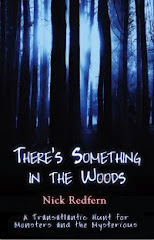The Cult of the Moon Beast
Posted by: Nick Redfern on February 20th, 2013

Over the years I’ve done more than a few investigations into strange and disturbing mutilations of animals in the UK – much of which was prompted by the fact that, as a kid, I lived only about 5-minutes from where the very controversial saga of George Edalji (pictured below) went down. In other words, as the Edalji affair was known all across the little villages of the area I grew up in, I was exposed to the phenomenon from an early age.

But, we’re not talking about anything along the lines of cattle mutilations.
Rather, we’re talking about ritualistic sacrifice and the summoning up of strange and bizarre beasts as a consequence and result of those sacrifices. Some of those beasts are of a definitively cryptozoological nature.
In my 2008 book, There’s Something in the Woods, I detailed a series of such events that occurred in Devonshire, England in 2006; and my 2012 book Monster Diary reveals my findings on an ancient Scottish group – the Taigheirm – that got up to similar things in centuries-past, and which may still exist.

One of the weirdest stories that falls into this category came to me in 2000 by a guy named Rob Lea. It’s a very odd and lengthy saga filled with conspiracy, werewolves, slaughtered sheep, and much, much more.
And Rob’s story is the focus of my latest Mysterious Universe post, which starts as follows:
“Just a few days ago, I was going through a bunch of old files, and came across a wealth of accounts that I have not given much thought to for many a year. One stands out of particular interest. On August 31, 2000 – a year before I moved to the United States – a man named Rob Lea telephoned me, and, in somewhat excited, but also distinctly worried, tones, informed me that for a number of years he had been near-obsessively pursuing an elite and powerful body of people engaged in the mutilation and sacrifice of animals in the UK, via ancient rite and ritual no less, for purposes relative to personal wealth, incredible power and, even, cold-blooded, heartless murder.
“Needless to say, I wanted, and needed, to hear more – much more, in fact. Two days later, I drove to an old pub in the picturesque English village of Milford – our arranged point of contact – where I was to meet with my concerned informant. Rob had seen my photograph in a then-recent edition of the local Chase Post newspaper, in which I had referenced the animal-mutilation controversy and which had specifically prompted him to contact me, and offered a friendly wave from his chair as I stood at the bar and ordered a refreshing, cold pint of beer.”
About Nick Redfern
Punk music fan, Tennents Super and Carlsberg Special Brew beer fan, horror film fan, chocolate fan, like to wear black clothes, like to stay up late. Work as a writer.










Meh, I prefer Track of the Moon Beast.
MST3K: Best. Show. Ever. ‘Nuf said!
Nick: You appear unwilling to grasp that Cryptozoology is, by definition, the “Study of unknown animals.”
As a case in point, after reading your post, I must question how any “strange and bizarre beasts” that are “summon(ed) up” … “as a consequence and result of… sacrifices” can rightly be termed “of a definitively cryptozoological nature”?
Either the “beasts” are flesh-and-blood entities and subject to actual scientific investigation i.e., worthy of Cryptozoological study, or they are “a form of non-physical intelligence that could take on the appearance of whatever was in the mind’s eye of the beholder” and therefore, more rightly, belong to the Paranormal/Spiritual realms.
Cryptozoology always has been – and remains – the study of unknown animals – potentially “real” animals – so, continuing to bang your fists against the door and screaming “It ain’t so,” doesn’t change the matter.
Don’t get me wrong. While I enjoy reading your posts about high strangeness encounters with shape-shifting multidimensional entities and the like, your attempts to shoehorn them into the field of Cryptozoology are incorrect and unacceptable. Instead, call them what they are, the Paranormal, and leave Cryptozoology to Bigfoot, Lake Monsters, Sea Serpents and their ilk.
AreWeThereYeti:
I thought you had gone? And had asked someone to turn out the lights.
Couple of things: I don’t believe in any of my posts I have ever done the equivalent of screaming or pounding my fists. Rather, I have offered my opinion in a logical and clear fashion. You may not agree with my conclusions, but suggesting I’m screaming or pounding my fists is way off mark.
I never scream (that’s a girly thing).
Yes, I understand – totally – the view that Cryptozoology is (or should be) the study of unknown animals. I really do get it!
But here’s the deal. You say:
“While I enjoy reading your posts about high strangeness encounters with shape-shifting multidimensional entities and the like, your attempts to shoehorn them into the field of Cryptozoology are incorrect and unacceptable. Instead, call them what they are, the Paranormal, and leave Cryptozoology to Bigfoot, Lake Monsters, Sea Serpents and their ilk.”
Yes, I do think they are paranormal. But here’s the thing: there are Bigfoot and lake-monster cases that do have paranormal/Fortean aspects to them. Check out Ted Holiday’s work on lake-monsters. Or Stan Gordon’s book, Silent Invasion. Or my Wildman! book on the British Bigfoot.
So, in other words, some of the creatures that you suggest should fall into the category of Cryptozoology actually have very curious overtones to them, which does push them down the paranormal path. That’s why I feel Cryptozoology needs to broaden its outlook.
If there were only paranormal aspects to (just as an example) werewolf reports, and never to Bigfoot, then of course I would keep the Paranormal out of Cryptozoology, and would keep the two totally apart. But, we DO get odd Bigfoot reports (more than a few actually).
That’s why I have a hard time with the idea of Cryptozoology being the study of just unknown animals, when the very ones you cite (Bigfoot and lake-monsters) do have strange aspects to them that go beyond regular animals.
Or do you take the view that every single person who has seen a Bigfoot – and reported some sort of Fortean overtone in relation to the sighting – is 100 percent wrong in what they reported?
That’s my point: it’s totally ok to argue that Cryptozoology is the study of unknown animals, but when those animals seem to be something more than just unknown animals, I feel Cryptozoology should have a wider range.
Or, if Bigfoot does have paranormal qualities, but we keep Cryptozoology as what you want it to be, then arguably we should remove Bigfoot from the field of Cryptozoology.
hello? anybody here?
Nick:
Still not my first choice. But, since the lights remain on, I still stop-by occasionally to see what’s what.
BTW, A little touchy are we? “Pounding your fists against the door & screaming…” Just a figure of speech. Nothing more. Honest! I suspect you’re not really that thin-skinned in real life…
Anyway, you mention the various crypto-critters which appear to have paranormal/Fortean overtones and question whether I believe “every single person who has seen a Bigfoot – and reported some sort of Fortean overtone in relation to the sighting – is 100 percent wrong in what they reported?”
Frankly, the VAST MAJORITY of sightings of cryptids such as Bigfoot, Nessie, various Sea Serpents, etc., DO represent reports of corporeal, flesh-and-blood creatures. Creatures that are part of, interact with, and obey the natural laws of, the real world.
The fact that a few people – a VERY FEW – out of the total eyewitnesses pool, may assign Fortean aspects to the creatures they have allegedly seen, doesn’t surprise me. Let’s face it, some people claim to see Jesus on a potato chip! Are they wrong? Not in their minds – but you won’t convince them otherwise!
Assuming “your” (for want of a better term) eyewitnesses are not making it up, I imagine the shock of glimpsing a cryptid – Bigfoot, or whatever – might be an earthshaking, awe-inspiring, even spiritual experience to those inclined to see it that way.
Do I, therefore, take the view that every single person who has seen a Bigfoot – and reported some sort of Fortean overtone in relation to the sighting – is 100 percent wrong in what they reported? No. But because those high-strangeness cases comprise such a small fraction of all sightings, I do question whether they might represent individuals’ perceptions being shaped by their beliefs and/or preconceptions; they saw what they “saw” and believed it to be so, or they attached some sort of mystical baggage to what might have been a real-world encounter.
So, while you choose to emphasize the rarely-reported paranormal qualities assigned to Bigfoot, et al., as reason to expand the definition of Cryptozoology – or suggest certain entities be excluded therefrom – I feel just as confident with the status quo; pursuing the vast remainder of reports which deal with “real” animals and letting the fringe reports remain just that.
I’ll bet I didn’t change your mind, right? So I guess we’ll have to agree to disagree on this…